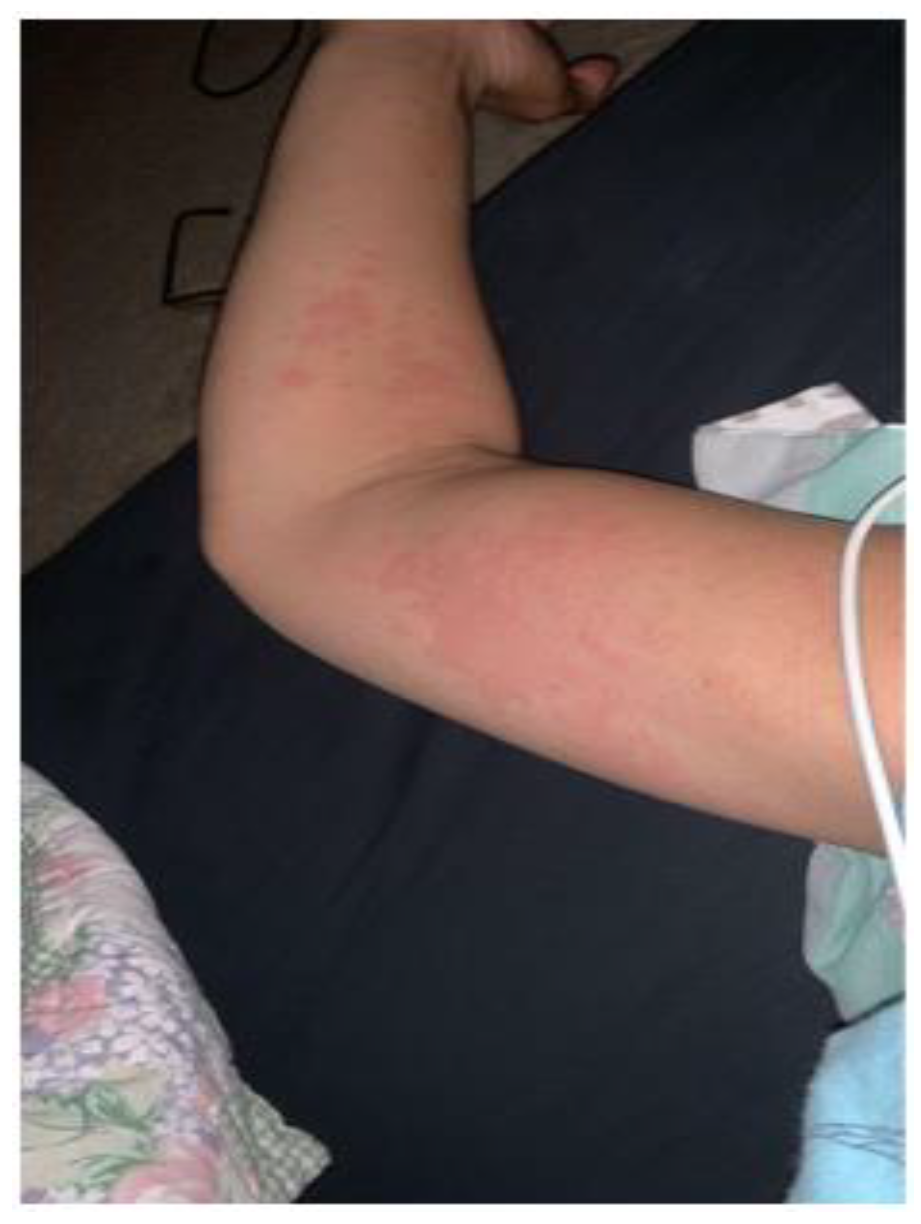“I was Determined to Fulfill This Image of Myself That I Wanted of a ‘Good Asian Student’”: A Photovoice Study of Asian American College Student Mental Health
[ad_1]
1. Introduction
2. The Present Study
Mental health has been identified as needing critical public health intervention. AsAs generally, and college students particularly, have received precious little research attention, leaving the problem of disparate mental health outcomes poorly understood, hidden within aggregated data, and thus difficult to interrupt. The gap in scientific understanding extends to risk and protective factors, attitudes and understandings, and engagement and effective interventions, to name only some. As such, this study meets an urgent need to expand knowledge about how AsA college students conceptualize mental health. The present exploratory study asks the following question: What facilitates or hinders the mental health of AsA undergraduate students from a large public university in central Texas?
3. Methods
3.1. Photovoice
3.2. Sampling
3.3. Interview Process
3.4. Analysis
3.5. Trustworthiness
4. Researchers’ Positionality Statements
Lalaine Sevillano, the first author is a currently abled cisgender female Pilipinx immigrant and settler. She/they/siya now holds advanced degrees, but grew up holding low socioeconomic status and is a first generation college student. Like many of the AsA students in this study, she also struggled with navigating her/their AsA identity. The second author, Joanna La Torre is a mixed race, second generation, Pilipinx settler, gender/queer Indigenist, decolonial, feminist scholar from middle socioeconomic background. They are a first generation graduate school student who had challenges navigating AsA identity throughout their life. The third author, Taylor Geyton, is a Black American, cis-gender, bi-sexual, woman, from a lower-middle socioeconomic background who was raised in a protestant Christian faith and has since begun to practice Traditional African Religions. She is an activist-scholar-educator and a Licensed Clinical Social Worker.
5. Findings
5.1. Participants
5.2. Photovoice Data
The 14 participants submitted 21 photographs and captions responding to the prompt for images that represented mental and physical health. Participants were given the opportunity to discuss at least three of the photographs submitted in response to the four prompts. Twelve out of the fourteen participants elected to speak about the photo(s) they submitted for the prompt on mental and physical health. As such, the analytical sample also includes 12 transcript excerpts during which participants discussed submitted photo(s).
Four themes developed from the data, including: (Theme 1) mind–body health connection meaning that mental health is about the synchronization of one’s mind and body; (Theme 2) environmental connectedness and the view that mental health is connected to nature; (Theme 3) social connectedness and how interpersonal relationships influenced mental health; and (Theme 4) internalization of the “good Asian student” stereotype and its impact on mental health. These themes are illustrated by the respondents’ photos, captions, and oral discussions of the photographs.
6. Theme: Mind–Body Health Connection
Participants described how mental health was linked to their physical health. They depicted and described experiences when psychological distress manifested as somatic symptoms, when physical health exacerbated mental health challenges and vice versa, and how physical activity and health behaviors impacted mental health.
In the examples provided by Roman and Jellybean, the discomfort experienced in their bodies is integral to their mental states and indicative of their mental health. Further, Jellybean’s self-portrait is out of focus, conveying even more the sense of struggle she is enduring at the time the photo was taken. Jellybean’s account of her experience at that time represents her difficulty differentiating between the multiple challenges she faced. In both examples, the body betrayed the mental health of the participant because, as Roman astutely points out, “the body knows”.
And I crushed up Celsius (brand of energy drink) to represent my mental state at the moment. It’s not doing good, and how even with the added help of caffeine to help push through this final stand, it took a large toll on my mentality. And also with just my physical being as well. Eating habits were terrible during this time. I don’t think I ate for a couple of days, or at least not consistently.
As Grand described, she views the caffeine from the energy drink as necessary for her performance, especially her ability to push through; however, she simultaneously recognizes its negative mental health impact. Participants also shared that health behaviors, such as engaging in physical activity, helped with positive mental health. For example, Spencer said “I love to exercise and move my body”, and Redacted said walking helps him to de-stress.
7. Theme: Environmental Connectedness
Spencer, Blue, and Redacted share important insights about how connecting with nature helps enhance their mental health. This comes in the form of relaxation, connecting with beauty, moving their bodies, and a space to connect with friends.
8. Theme: Social Connectedness
Participants highlighted the importance of social connectedness and how it contributes to their sense of belonging, loneliness, and anxiety. This theme was divided into four sub-themes of family, peers, university, and COVID-19 to further contextualize how connections with people mattered to and, in some cases, complicated their mental health.
8.1. Sub-Theme: Family
The support Eli receives from her family is notably embedded within culture, both as a praxis and a site of reproduction. That is, the family depicted sits down to enjoy culturally specific foods endowed with meaning and practice and, in so doing, reproduces culturally laden praxes, including ways of connecting with family, ways of receiving support, and practices of membership and identity. In this way, Eli’s example demonstrates integral sustenance practices that span physical, social, and cultural spaces, all while enduring a misalignment regarding mental health in the diasporic context.
Lana’s resilience is also captured in the moment photographed and her telling of it, as she identifies and externalizes her knowledge that the beauty standards she and her family were/are subjected to are “unrealistic”. In this way, Lana demonstrates a growing critical consciousness that uproots the white supremacist beauty ideals she has been subjected to and potentially widens the path for centering herself in the knowledge of her beauty. Regardless, the photo captures one moment of victory and joy over the harmful messages she received throughout her lifetime. Roman also alluded to tensions with his family and how those conflicts potentially contributed to the aforementioned stress-induced hives: “They kept holding on to this childhood version of me and it was causing a lot of tension and friction. […] It definitely is a journey on its own when explaining to your parents that you’re not the same child, you’re not a baby anymore”. Roman describes developmentally appropriate issues of differentiation and how his body reacted to this process. In these examples, family is intertwined with cultural, historical, and socioeconomic forces (e.g., immigration) that produce both risks and benefits due to the broader systemic forces at play (e.g., racism). Asian families moving to the U.S. undergo enculturation and acculturation processes known to catalyze generational differences in epistemology, lived experience, health, and mental health. As such, family connectedness represents an integral theme for AsA college students as a liminal space of emergence as young adults and re-emergence as cultural (dis-)continuity within a fresh context.
8.2. Sub-Theme: Peers
8.3. Sub-Theme: Impact of COVID-19
Well, it is 10 o’clock, and I’m listening to a sad song. So, there’s that scene. And so this was essentially when I was [staying] up a little bit late and writing about the fact that I wished I could meet more people. But, I didn’t really know how, and also because of COVID restrictions, it’s also hard. It’s a little bit of a gamble to meet new people. Because well, I don’t really know where you are. I don’t know if you’re sick, you probably don’t have COVID, but if you do, I would have to go get tested. […] You can feel sort of lonely, and it’s hard to talk to other people about. First of all, it’s a bit embarrassing to talk about. And also, if you’re lonely, you don’t have that many people to talk to.
Hazel’s description and photo provide a palpable sense of the difficulties she experienced navigating the various hardships associated with the pandemic. She describes the competing pressures and needs of loneliness, pandemic safety protocols, social pressures, and loss of her anticipated college classroom experiences, all while navigating the mental health impacts of each of these separately and individually. The pain, fear, anxiety, and sadness mix together, along with developmental processes of emancipation and differentiation in this theme.
9. Theme: Internalization of the “Good Asian Student” Stereotype
And I don’t think this is [AsA] specific, but a lot of other immigrant students, first gen, low income students feel like a big pressure to be very successful and that also playing to the stereotype that by being first gen, I’m trying to assimilate and be successful. But, a lot of people are genuinely, extremely stressed by the workload and stuff. And a bit overwhelmed. At least compared to their peers that they feel the need to feel better to succeed. And a lot of times it is kind of unsustainable that I just collapse on the bed at times.
Despite recognizing a decline in their well-being (mental and physical), participants spoke about the need to “push through the academic pressure”, as Grand and Alphonse explained. For example, Jellybean was bedridden with a pelvic injury, yet she found herself “thinking about academics, […] and stressing about it”. The binary presented of being the “good” AsA student also denotes the presence of the bad AsA student and all the implications therein, including the meanings ascribed to not performing up to the stereotyped level. To avoid this, the students put their physical and mental health on the line, even when, as with Jellybean, they experienced serious consequences pushing through to perform. Distinct from the insight illustrated when contending with racialized messages around beauty standards, the participants did not externalize the pressures to perform by locating them within harmful white supremacist discourses, which suggests that the stereotype remains intact internally. That is, though Grand identified the presence of the “good” Asian (i.e., the model minority stereotype), they did not challenge the stereotype itself or link it with broader contextual factors; thus, he remains subject to the binary outcomes of good/bad.
When asked what advice they would give to other AsA students about mental health, many participants suggested that AsA students should strive for a better sense of work–life balance as Blue recommended:
I feel academics are extremely important. But it’s also important to make sure that you are having fun in life and that you’re getting out there and you’re doing stuff that makes you happy. […] Your time at UT is a very short one—make sure to get the most out of it. You’re not just focusing on school, but you’re also, putting out some time to … make sure that your grades are good, but make sure that you’re also having fun and that you’re in a good place mentally.
Redacted added, “They should socialize […] Being in college is not about studying all the time. You should also take time to look for hobbies or, it’s time to find what you like and don’t like”. Blue and Redacted’s shared sentiments maintain the impetus for a work–life balance to be on the AsA students themselves rather than adjusting external factors. Without a structural basis for shifting the material, pleas for heeding a hypothesized work–life balance function more like a paltry sentiment rather than actual change.
Alphonse expressed, “I don’t really have a good solution for that. But I wish there was more awareness that a lot of students are overworking and employing these bad mental health strategies”. Roman emphasized the need to normalize mental health help-seeking and suggested the following: “I guess investing more in or at least promoting students to take a more active approach to their mental health”. Jellybean shared that taking a mindfulness class could be a potential strategy to promote mental health, particularly around self-compassion. She warned other AsA students:
[…] don’t ignore how you’re really feeling and act like it’s not there. If you just ignore it, there’s just going to be so many unresolved things that you’re gonna have to deal with in the future, and that’s going to give you anxiety. I don’t know, it just all piles up, and it will show on your physical health and your mental health.
In summary, this theme described how the internalization of the “Good Asian Student” stereotype manifests and shapes the bio–psycho–social well-being of AsA students.
10. Concept Map
11. Discussion
In this study, we present a novel contribution to the empirical literature by providing the first Photovoice exploration, to our knowledge, of mental health among AsA emerging adults in the southern U.S. during the COVID-19 pandemic. Our findings suggest four themes: (Theme 1) mind–body health connection and the experience that mental health is about the synchronization of one’s mind and body; (Theme 2) environmental connectedness and the view that mental health is connected to nature; (Theme 3) social connectedness and how interpersonal relationships influenced mental health; and (Theme 4) internalization of the “good Asian student” stereotype and its impact on mental health. As aforementioned, our concept map captures how the themes come together to form a higher level understanding of the ways AsA emerging adults conceptualize mental health. Specifically, the concept map indicates that mental health has different states of harmonious, disjointed, or restorative based on the cohesion of mental, physical, and universal connectedness. Definitions of mental health continue to evolve. Our findings are aligned with Galderisi and colleagues’ more holistic definition which is gaining global attention:
Mental health is a dynamic state of internal equilibrium which enables individuals to use their abilities in harmony with universal values of society. Basic cognitive and social skills; ability to recognize, express and modulate one’s own emotions, as well as empathize with others; flexibility and ability to cope with adverse life events and function in social roles; and harmonious relationship between body and mind represent important components of mental health which contribute, to varying degrees, to the state of internal equilibrium [33].
This definition corresponds to our findings that mental health is an ever-changing condition with active shifts in balancing mental, physical, and social components of well-being. Additionally, this definition of mental health also highlights the idea of harmony which our findings elucidate.
11.1. Harmonious Mental Health
11.2. Disrupted Mental Health
In summary, AsA emerging adults believe that optimal mental health is maintained through harmonious connections with the self (mind–body) and the universe (nature, peers, family).
11.3. Restorative Mental Health
The third state of mental health captures the lessons learned and the advice participants offered to other AsA emerging adults about how to restore their mental health. First, participants suggested practicing mindfulness as a way to critically reflect on one’s emotions, needs, and challenges. Jellybean described a key takeaway from her educational psychology course entitled “Mindfulness: The Self and Compassion” was to not ignore concerns as they will breed even more unresolved issues. Instead, she learned to acknowledge problems as they arise and ask herself questions like “How am I feeling about this? Is there anything I can do to fix how I’m feeling? What are the steps that I can take to make my situation feel a little bit better?” She argued that if she had learned these tools earlier, her “mental health would have been in a better situation [… I would have] overcome my anxiety instead of stressing about everything”.
12. Implications
12.1. Challenges and Future Opportunities
12.2. Practical Recommendations
13. Conclusions
Author Contributions
Conceptualization, L.S.; Methodology, L.S.; Validation, L.S., J.C.L.T. and T.A.G.; Formal analysis, L.S.; Investigation, L.S.; Resources, L.S.; Data curation, L.S.; Writing—original draft, L.S., J.C.L.T. and T.A.G.; Writing—review and editing, L.S. and J.C.L.T.; Supervision, L.S.; Project administration, L.S. All authors have read and agreed to the published version of the manuscript.
Funding
This research received no external funding.
Institutional Review Board Statement
The study was conducted in accordance with the Declaration of Helsinki, and approved by the Institutional Review Board of the University of Texas at Austin (STUDY00002058 and approved on 22 November 2021).
Informed Consent Statement
Informed consent was obtained from all subjects involved in the study.
Data Availability Statement
Acknowledgments
Thanks to the students who shared their stories with us both through words and pictures. We also appreciate seed funding from the University of Texas at Austin’s Office of the Vice Provost for Diversity to be able to provide incentives to students who participated.
Conflicts of Interest
The authors declare no conflicts of interest. The funding sponsors had no role in the design of the study; in the collection, analyses, or interpretation of data; in the writing of the manuscript, nor in the decision to publish the results.
References
- U.S. Pew Research Center. 2021. Available online: https://www.pewresearch.org/short-reads/2021/04/09/asian-americans-are-the-fastest-growing-racial-or-ethnic-group-in-the-u-s/ (accessed on 2 February 2024).
- Iyer, P.; Parmar, D.; Ganson, K.T.; Tabler, J.; Soleimanpour, S.; Nagata, J.M. Investigating Asian American Adolescents’ Resiliency Factors and Young Adult Mental Health Outcomes at 14-year Follow-up: A Nationally Representative Prospective Cohort Study. J. Immigr. Minor. Health 2022, 25, 75–85. [Google Scholar] [CrossRef] [PubMed]
- US Census Bureau. Census Bureau Data. 2020. Available online: https://data.census.gov/ (accessed on 6 March 2024).
- Office of Minority Health. Mental and Behavioral Health—Asian Americans. US Department of Health and Human Services. 2021. Available online: https://minorityhealth.hhs.gov/mental-and-behavioral-health-asian-americans (accessed on 2 February 2024).
- WHO. Mental Health. World Health Organization. 2022. Available online: https://www.who.int/news-room/fact-sheets/detail/mental-health-strengthening-our-response (accessed on 2 February 2024).
- Dong, H.; Dai, J.; Lipson, S.K.; Curry, L. Help-seeking for mental health services in Asian American college students: An exploratory qualitative study. J. Am. Coll. Health 2020, 70, 2303–2310. [Google Scholar] [CrossRef] [PubMed]
- Huynh, J.; Chien, J.; Nguyen, A.T.; Honda, D.; Cho, E.E.; Ngo, T.D. The mental health of Asian American adolescents and young adults amid the rise of anti-Asian racism. Front. Public Health 2023, 10, 958517. [Google Scholar] [CrossRef] [PubMed]
- Ðoàn, L.N.; Takata, Y.; Sakuma, K.L.K.; Irvin, V.L. Trends in Clinical Research Including Asian American, Native Hawaiian, and Pacific Islander Participants Funded by the US National Institutes of Health, 1992 to 2018. JAMA Netw. Open 2019, 2, e197432. [Google Scholar] [CrossRef]
- Museus, S.D.; Kiang, P.N. Deconstructing the model minority myth and how it contributes to the invisible minority reality in higher education research. New Dir. Institutional Res. 2009, 142, 5–15. [Google Scholar] [CrossRef]
- SAMHSA. National Survey on Drug Use and Health: 2-Year RDAS (2019 to 2020). Substance Abuse and Mental Health Services Administration. 2020. Available online: https://datatools-samhsa-gov.proxy.lib.pdx.edu/#/ (accessed on 2 February 2024).
- Lipson, S.K.; Zhou, S.; Abelson, S.; Heinze, J.; Jirsa, M.; Morigney, J.; Patterson, A.; Singh, M.; Eisenberg, D. Trends in college student mental health and help-seeking by race/ethnicity: Findings from the national healthy minds study, 2013–2021. J. Affect. Disord. 2022, 306, 138–147. [Google Scholar] [CrossRef]
- Choi, Y.; Park, M.; Noh, S.; Lee, J.P.; Takeuchi, D. Asian American mental health: Longitudinal trend and explanatory factors among young Filipino- and Korean Americans. SSM—Popul. Health 2020, 10, 100542. [Google Scholar] [CrossRef]
- Kim, J.E.; Zane, N. Help-seeking intentions among Asian American and White American students in psychological distress: Application of the health belief model. Cult. Divers. Ethn. Minor. Psychol. 2016, 22, 311–321. [Google Scholar] [CrossRef] [PubMed]
- Lipson, S.K.; Kern, A.; Eisenberg, D.; Breland-Noble, A.M. Mental Health Disparities Among College Students of Color. J. Adolesc. Health 2018, 63, 348–356. [Google Scholar] [CrossRef]
- Kam, B.; Mendoza, H.; Masuda, A. Mental health help-seeking experience and attitudes in Latina/o American, Asian American, Black American, and White American college students. Int. J. Adv. Couns. 2019, 41, 492–508. [Google Scholar] [CrossRef]
- Cheng, H.-L.; Kwan, K.-L.K.; Sevig, T. Racial and ethnic minority college students’ stigma associated with seeking psychological help: Examining psychocultural correlates. J. Couns. Psychol. 2013, 60, 98–111. [Google Scholar] [CrossRef]
- Kessler, R.C.; Berglund, P.; Demler, O.; Jin, R.; Merikangas, K.R.; Walters, E.E. Lifetime Prevalence and Age-of-Onset Distributions of DSM-IV Disorders in the National Comorbidity Survey Replication. Arch. Gen. Psychiatry 2005, 62, 593–602. [Google Scholar] [CrossRef]
- Sevillano, L. Resisting the New Yellow Peril: Internalized Racism and Critical Consciousness in Asian, Pacific Islander, Desi Americans. Ph.D. Thesis, University of Texas at Austin, Austin, TX, USA, 2022. embargo in place until May 2027. [Google Scholar]
- Sutton-Brown, C.A. Photovoice: A Methodological Guide. Photogr. Cult. 2014, 7, 169–185. [Google Scholar] [CrossRef]
- Wang, C.; Burris, M.A. Photovoice: Concept, Methodology, and Use for Participatory Needs Assessment. Health Educ. Behav. 1997, 24, 369–387. [Google Scholar] [CrossRef] [PubMed]
- Yosso, T.J. Whose culture has capital? A critical race theory discussion of community cultural wealth. Race Ethn. Educ. 2005, 8, 69–91. [Google Scholar] [CrossRef]
- David, E.J.R.; Okazaki, S. The Colonial Mentality Scale (CMS) for Filipino Americans: Scale construction and psychological implications. J. Couns. Psychol. 2006, 53, 241–252. [Google Scholar] [CrossRef]
- Rapa, L.J.; Bolding, C.W.; Jamil, F.M. Development and initial validation of the short critical consciousness scale (CCS-S). J. Appl. Dev. Psychol. 2020, 70, 101164. [Google Scholar] [CrossRef]
- Hussey, W. Mph Slivers of the Journey: The Use of Photovoice and Storytelling to Examine Female to Male Transsexuals’ Experience of Health Care Access. J. Homosex. 2006, 51, 129–158. [Google Scholar] [CrossRef]
- Braun, V.; Clarke, V. Using thematic analysis in psychology. Qual. Res. Psychol. 2006, 3, 77–101. [Google Scholar] [CrossRef]
- Meyer, K.; Willis, R. Looking Back to Move Forward: The Value of Reflexive Journaling for Novice Researchers. J. Gerontol. Soc. Work 2019, 62, 578–585. [Google Scholar] [CrossRef]
- Tobin, G.A.; Begley, C.M. Methodological rigour within a qualitative framework. J. Adv. Nurs. 2004, 48, 388–396. [Google Scholar] [CrossRef]
- Hill, C.E.; Thompson, B.J.; Williams, E.N. A Guide to Conducting Consensual Qualitative Research. Couns. Psychol. 1997, 25, 517–572. [Google Scholar] [CrossRef]
- Carr, W. Partisanship in Educational Research. Oxf. Rev. Educ. 2000, 26, 437–449. [Google Scholar] [CrossRef]
- Roberts, S.O.; Bareket-Shavit, C.; Dollins, F.A.; Goldie, P.D.; Mortenson, E. Racial Inequality in Psychological Research: Trends of the Past and Recommendations for the Future. Perspect. Psychol. Sci. 2020, 15, 1295–1309. [Google Scholar] [CrossRef]
- Holmes, A.G.D. Researcher Positionality—A Consideration of Its Influence and Place in Qualitative Research—A New Researcher Guide. Shanlax Int. J. Educ. 2020, 8, 1–10. [Google Scholar] [CrossRef]
- Byrne, D. A worked example of Braun and Clarke’s approach to reflexive thematic analysis. Qual. Quant. 2021, 56, 1391–1412. [Google Scholar] [CrossRef]
- Galderisi, S.; Heinz, A.; Kastrup, M.; Beezhold, J.; Sartorius, N. Toward a new definition of mental health. World Psychiatry 2015, 14, 231. [Google Scholar] [CrossRef] [PubMed]
- Yeh, C.J. Depathologizing Asian American Perspectives of Health and Healing. Asian Am. Pac. Isl. J. Health 2000, 8, 138–149. [Google Scholar] [PubMed]
- Prathikanti, S. East Indians American families. In Working with Asian Americans: A Guide for Clinicians; Lee, E., Ed.; The Guilford Press: New York, NY, USA, 1997; pp. 79–100. [Google Scholar]
- McBride, M. Health and Health Care of Filipino American Elders. Retrieved from Stanford Geriatric Education Center. 2001. Available online: https://geriatrics.stanford.edu/wp-content/uploads/downloads/ethnomed/filipino/downloads/filipino_american.pdf (accessed on 1 March 2024).
- Torsch, V.L.; Ma, G.X. Cross-Cultural Comparison of Health Perceptions, Concerns, and Coping Strategies among Asian and Pacific Islander American Elders. Qual. Health Res. 2000, 10, 471–489. [Google Scholar] [CrossRef] [PubMed]
- Yoo, N.; Nicholson, H.L.; Chang, D.F.; Okazaki, S. Mapping Anti-Asian Xenophobia: State-Level Variation in Implicit and Explicit Bias against Asian Americans across the United States. Socius 2023, 9, 23780231231196517. [Google Scholar] [CrossRef]
- Jackson, S.B.; Stevenson, K.T.; Larson, L.R.; Peterson, M.N.; Seekamp, E. Outdoor Activity Participation Improves Adolescents’ Mental Health and Well-Being during the COVID-19 Pandemic. Int. J. Environ. Res. Public Health 2021, 18, 2506. [Google Scholar] [CrossRef] [PubMed]
- Lee, S.; Waters, S.F. Asians and Asian Americans’ experiences of racial discrimination during the COVID-19 pandemic: Impacts on health outcomes and the buffering role of social support. Stigma Health 2021, 6, 70–78. [Google Scholar] [CrossRef]
- Kramer, E.J.; Kwong, K.; Lee, E.; Chung, H. Cultural factors influencing the mental health of Asian Americans. West. J. Med. 2002, 176, 227–231. [Google Scholar] [PubMed]
- Yip, K.-S. Chinese concepts of mental health: Cultural implications for social work practice. Int. Soc. Work 2005, 48, 391–407. [Google Scholar] [CrossRef]
- Yeh, C.J.; Inman, A.G.; Kim, A.B.; Okubo, Y. Asian American families’ collectivistic coping strategies in response to 9/11. Cult. Divers. Ethn. Minor. Psychol. 2006, 12, 134–148. [Google Scholar] [CrossRef]
- Noh, S.; Beiser, M.; Kaspar, V.; Hou, F.; Rummens, J. Perceived Racial Discrimination, Depression, and Coping: A Study of Southeast Asian Refugees in Canada. J. Health Soc. Behav. 1999, 40, 193–207. [Google Scholar] [CrossRef]
- Atkin, A.L.; Tran, A.G.T.T. The roles of ethnic identity and metastereotype awareness in the racial discrimination-psychological adjustment link for Asian Americans at predominantly White universities. Cult. Divers. Ethn. Minor. Psychol. 2020, 26, 498–508. [Google Scholar] [CrossRef]
- David, E.J.R. A colonial mentality model of depression for Filipino Americans. Cult. Divers. Ethn. Minor. Psychol. 2008, 14, 118–127. [Google Scholar] [CrossRef]
- Phinney, J.S.; Ong, A.D. Conceptualization and measurement of ethnic identity: Current status and future directions. J. Couns. Psychol. 2007, 54, 271–281. [Google Scholar] [CrossRef]
- Iwamoto, D.K.; Liu, W.M. The impact of racial identity, ethnic identity, Asian values, and race-related stress on Asian Americans and Asian international college students’ psychological well-being. J. Couns. Psychol. 2010, 57, 79–91. [Google Scholar] [CrossRef] [PubMed]
- Sevillano, L.; Macapugay, K. Understanding and dismantling the “model minority” stereotype. In Addressing Anti-Asian Racism with Social Work Advocacy and Action; Oxford University Press: Oxford, UK, 2024. [Google Scholar]
- Napier, A.D.; Ancarno, C.; Butler, B.; Calabrese, J.; Chater, A.; Chatterjee, H.; Guesnet, F.; Horne, R.; Jacyna, S.; Jadhav, S.; et al. Culture and health. Lancet 2014, 384, 1607–1639. [Google Scholar] [CrossRef]
- Singer, M.K. Applying the concept of culture to reduce health disparities through health behavior research. Prev. Med. 2012, 55, 356–361. [Google Scholar] [CrossRef] [PubMed]
- Mahalingam, R.; Rabelo, V.C. Teaching Mindfulness to Undergraduates: A Survey and Photovoice Study. J. Transform. Educ. 2018, 17, 51–70. [Google Scholar] [CrossRef]
- Werremeyer, A.; Skoy, E.; Burns, W.; Bach-Gorman, A. Photovoice as an intervention for college students living with mental illness: A pilot study. Ment. Health Clin. 2020, 10, 237–243. [Google Scholar] [CrossRef] [PubMed]
- Williams, C.D.; Byrd, C.M.; Quintana, S.M.; Anicama, C.; Kiang, L.; Umaña-Taylor, A.J.; Calzada, E.J.; Gautier, M.P.; Ejesi, K.; Tuitt, N.R.; et al. A Lifespan Model of Ethnic-Racial Identity. Res. Hum. Dev. 2020, 17, 99–129. [Google Scholar] [CrossRef] [PubMed]
- Stefancic, J.; Delgado, R. Critical Race Theory: An Introduction. Work Pap. Available online: https://scholarship.law.ua.edu/fac_working_papers/47 (accessed on 17 July 2010).
- Price-Feeney, M.; Green, A.E.; Dorison, S.H. Suicidality Among Youth Who are Questioning, Unsure of, or Exploring Their Sexual Identity. J. Sex Res. 2020, 58, 581–588. [Google Scholar] [CrossRef] [PubMed]
- Huey, S.J.; Tilley, J.L. Effects of mental health interventions with Asian Americans: A review and meta-analysis. J. Consult. Clin. Psychol. 2018, 86, 915–930. [Google Scholar] [CrossRef] [PubMed]
- Lau, A.S.; Chang, D.F.; Okazaki, S. Methodological challenges in treatment outcome research with ethnic minorities. Cult. Divers. Ethn. Minor. Psychol. 2010, 16, 573–580. [Google Scholar] [CrossRef]
- Marchand, A.; Beaulieu-Prévost, D.; Guay, S.; Bouchard, S.; Drouin, M.S.; Germain, V. Relative Efficacy of Cognitive-Behavioral Therapy Administered by Videoconference for Posttraumatic Stress Disorder: A Six-Month Follow-Up. J. Aggress. Maltreatment Trauma 2011, 20, 304–321. [Google Scholar] [CrossRef]
- Xin, R.; Fitzpatrick, O.M.; Lai, P.H.L.; Weisz, J.R.; Price, M.A. A Systematic Narrative Review of Cognitive-behavioral Therapies with Asian American Youth. Evid. Based Pract. Child Adolesc. Ment. Health 2022, 7, 198–212. [Google Scholar] [CrossRef]
- Huynh, T.; Torquati, J.C. Examining connection to nature and mindfulness at promoting psychological well-being. J. Environ. Psychol. 2019, 66, 101370. [Google Scholar] [CrossRef]
- Javier, J.R.; Galura, K.; Aliganga, F.A.P.; Supan, J.D.; Palinkas, L.A. Voices of the Filipino Community Describing the Importance of Family in Understanding Adolescent Behavioral Health Needs. Fam. Community Health 2018, 41, 64–71. [Google Scholar] [CrossRef] [PubMed]
- López, G.; Ruiz, N.; Patten, E. Key Facts about Asian Americans, a Diverse and Growing Population. Pew Res Cent. 2017. Available online: https://www.pewresearch.org/short-reads/2021/04/29/key-facts-about-asian-americans/ (accessed on 1 March 2024).
Figure 1.
Roman’s photo for mental health and well-being Photovoice prompt. Note the following caption is written by Roman: Poor mental health translating to physical health problems.
Figure 1.
Roman’s photo for mental health and well-being Photovoice prompt. Note the following caption is written by Roman: Poor mental health translating to physical health problems.
Figure 2.
JellyBean’s photo for mental health and well-being Photovoice prompt. Note the following caption is written by Jellybean: This was a photo I snapped at the end of last semester that I thought represented my mental and physical health situation really well. I’m sure you can see my sunken eyes, as I was extremely tired. This was the only day I went to campus last semester. I’ve had a plethora of health issues since I became a student at UT: pelvic injury that left me unable to walk, anemia that makes me extremely tired, diagnosed with [Attention-Deficit/Hyperactivity Disorder], and anxiety etc. Last semester was extremely hard for me, I ended up staying at home because I couldn’t deal with my health issues on my own, so I took the photo on the one special day I went to campus.
Figure 2.
JellyBean’s photo for mental health and well-being Photovoice prompt. Note the following caption is written by Jellybean: This was a photo I snapped at the end of last semester that I thought represented my mental and physical health situation really well. I’m sure you can see my sunken eyes, as I was extremely tired. This was the only day I went to campus last semester. I’ve had a plethora of health issues since I became a student at UT: pelvic injury that left me unable to walk, anemia that makes me extremely tired, diagnosed with [Attention-Deficit/Hyperactivity Disorder], and anxiety etc. Last semester was extremely hard for me, I ended up staying at home because I couldn’t deal with my health issues on my own, so I took the photo on the one special day I went to campus.
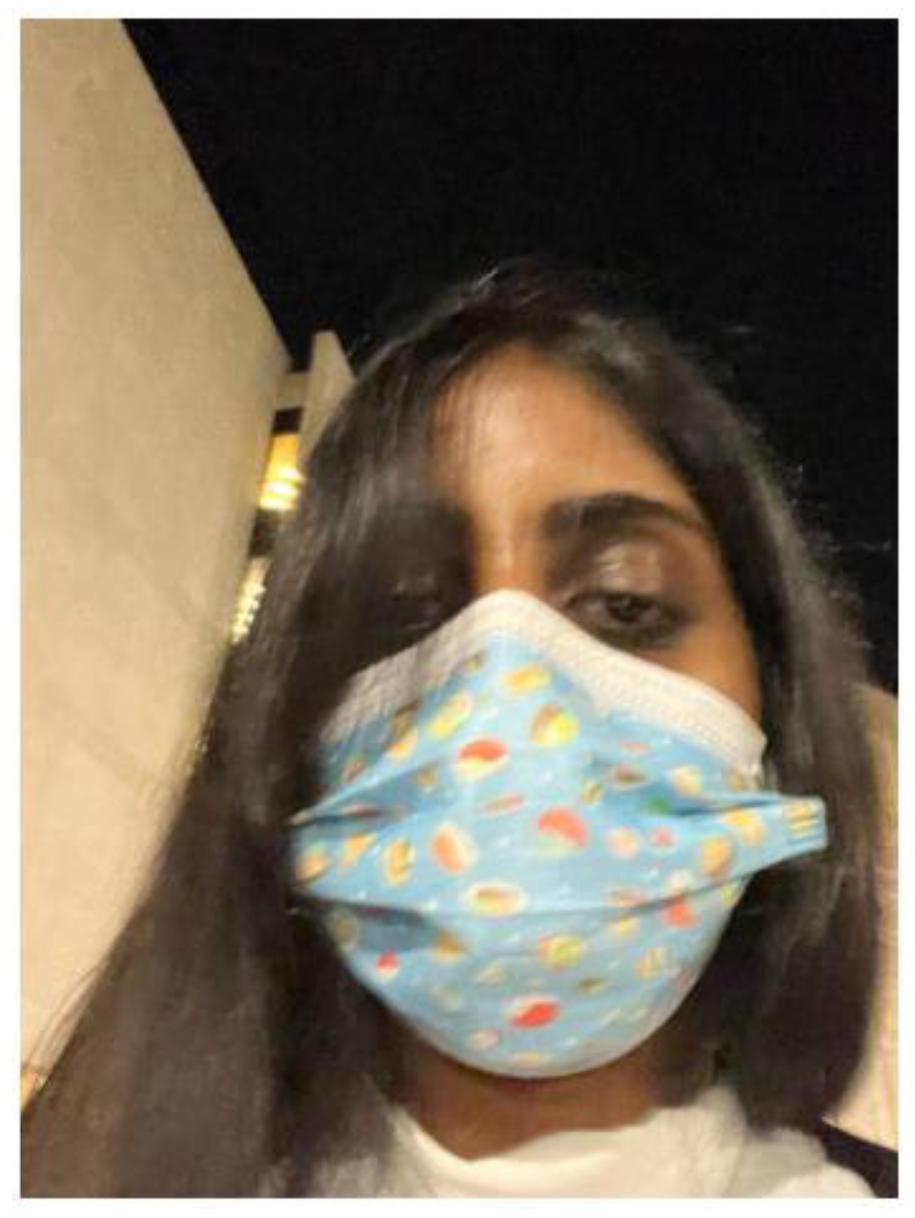
Figure 3.
Grand’s photo for mental health and well-being Photovoice prompt. Note that the following caption is written by Grand: The build up of various factors including school and societal pressures can reach the point of needing an extra boost to even get through the day. The can in this example represents the physical need to continue pushing forward no matter what and the mental toll it takes on my well being.
Figure 3.
Grand’s photo for mental health and well-being Photovoice prompt. Note that the following caption is written by Grand: The build up of various factors including school and societal pressures can reach the point of needing an extra boost to even get through the day. The can in this example represents the physical need to continue pushing forward no matter what and the mental toll it takes on my well being.
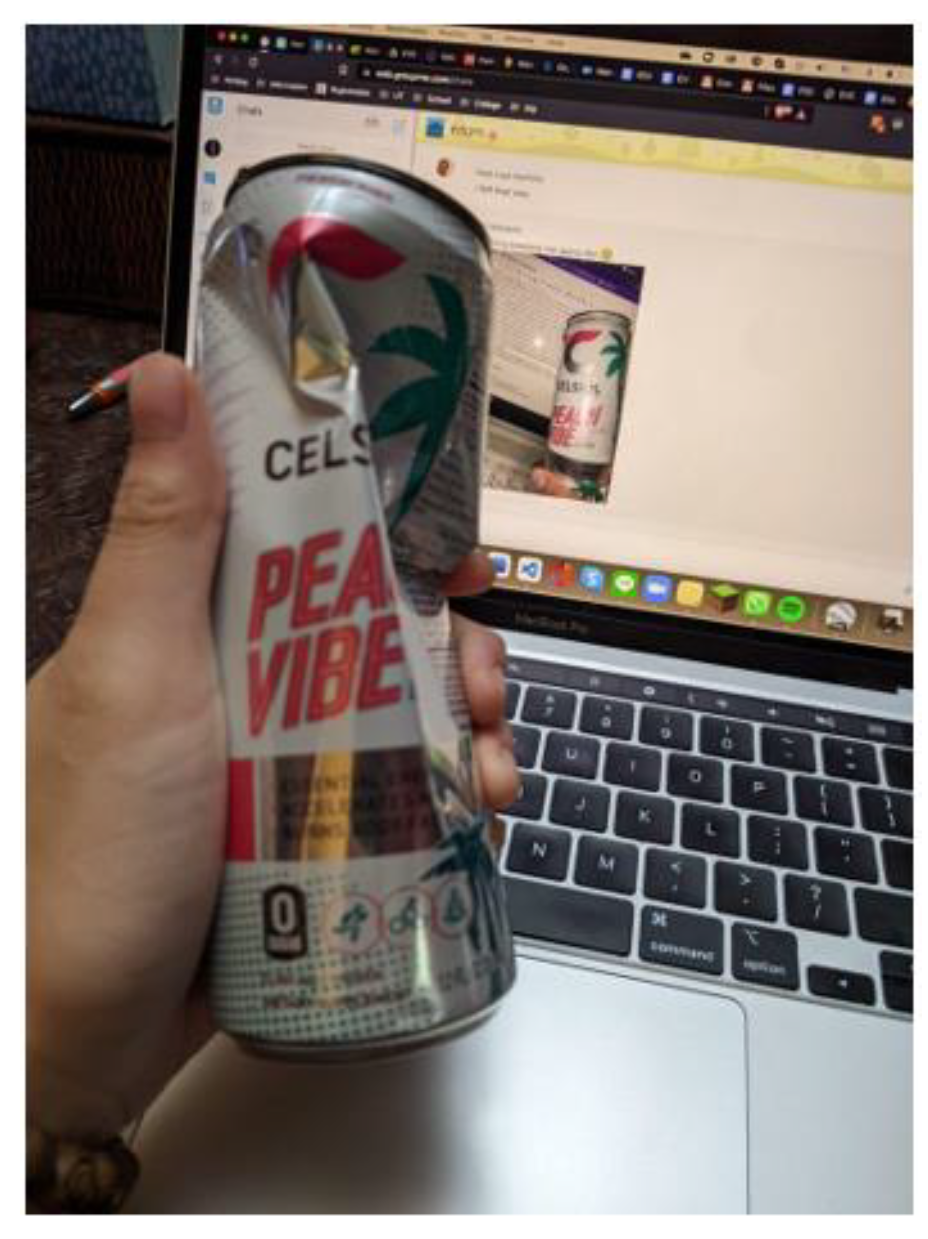
Figure 4.
Blue’s photo for mental health and well-being Photovoice prompt. Note that the caption is written by Blue: This shows two Asian kids gambling the night before a big test in order to take some of the stress away. This picture was taken to document the serenity of the environment, the sort of calm before the storm before the big test that would determine the grade the boys would receive in their [Management Information Systems] course.
Figure 4.
Blue’s photo for mental health and well-being Photovoice prompt. Note that the caption is written by Blue: This shows two Asian kids gambling the night before a big test in order to take some of the stress away. This picture was taken to document the serenity of the environment, the sort of calm before the storm before the big test that would determine the grade the boys would receive in their [Management Information Systems] course.
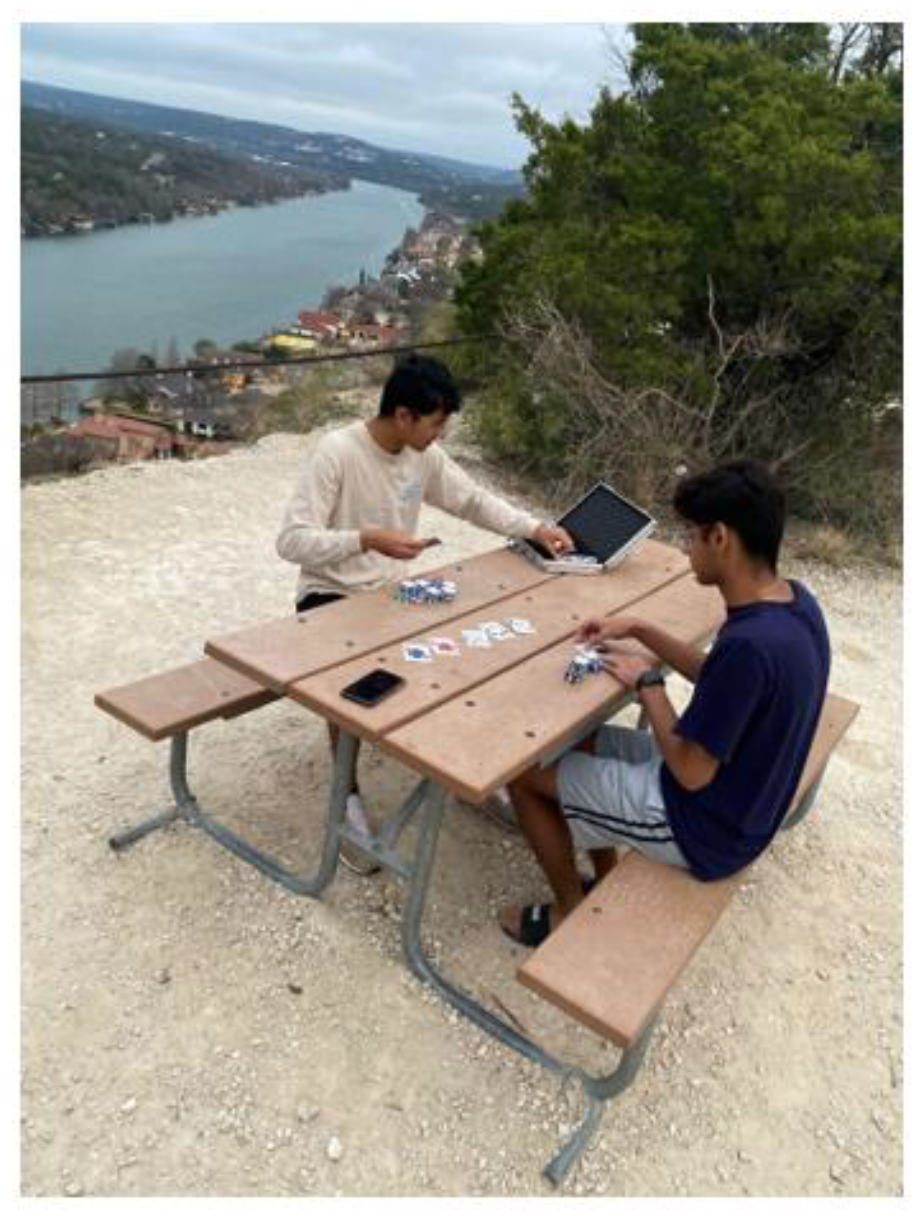
Figure 5.
Redacted’s photo for mental health and well-being Photovoice prompt. Note that the caption is written by Redacted: Walking around Austin, being outside helps [de-stress] from studying.
Figure 5.
Redacted’s photo for mental health and well-being Photovoice prompt. Note that the caption is written by Redacted: Walking around Austin, being outside helps [de-stress] from studying.

Figure 6.
Spencer’s Photo (b) for mental health and well-being Photovoice prompt. Note that the caption is written by Spencer: I am pictured taking a photo of the sun setting over Lady Bird Lake. Being outside plays a big role in my mental health. I love to exercise and move my body, but I also love to capture what I see so I can remember it whenever I need a pick-me-up.
Figure 6.
Spencer’s Photo (b) for mental health and well-being Photovoice prompt. Note that the caption is written by Spencer: I am pictured taking a photo of the sun setting over Lady Bird Lake. Being outside plays a big role in my mental health. I love to exercise and move my body, but I also love to capture what I see so I can remember it whenever I need a pick-me-up.

Figure 7.
Spencer’s photo (a) for mental health and well-being Photovoice prompt. Note that the caption is written by Spencer: My friend leans over to look closer at the water at Zilker Park. Walking in nature, and chatting with friends, is the ultimate relaxation. We talk about our weeks, our struggles, our joys, anything is fair game. It is so comforting and encourages me to keep going.
Figure 7.
Spencer’s photo (a) for mental health and well-being Photovoice prompt. Note that the caption is written by Spencer: My friend leans over to look closer at the water at Zilker Park. Walking in nature, and chatting with friends, is the ultimate relaxation. We talk about our weeks, our struggles, our joys, anything is fair game. It is so comforting and encourages me to keep going.

Figure 8.
Eli’s photo for mental health and well-being Photovoice prompt. Note that the caption is written by Eli: This is a picture of my family sitting down to a dinner of Indian food. I took this picture because my family is very important to me and have been a great support system. I am grateful for this as this is not very common in Asian families, where parents are often strict and demanding of their children. Also, mental health is a difficult subject in my family, and while my parents are supportive, they don’t quite understand my relationship with it.
Figure 8.
Eli’s photo for mental health and well-being Photovoice prompt. Note that the caption is written by Eli: This is a picture of my family sitting down to a dinner of Indian food. I took this picture because my family is very important to me and have been a great support system. I am grateful for this as this is not very common in Asian families, where parents are often strict and demanding of their children. Also, mental health is a difficult subject in my family, and while my parents are supportive, they don’t quite understand my relationship with it.
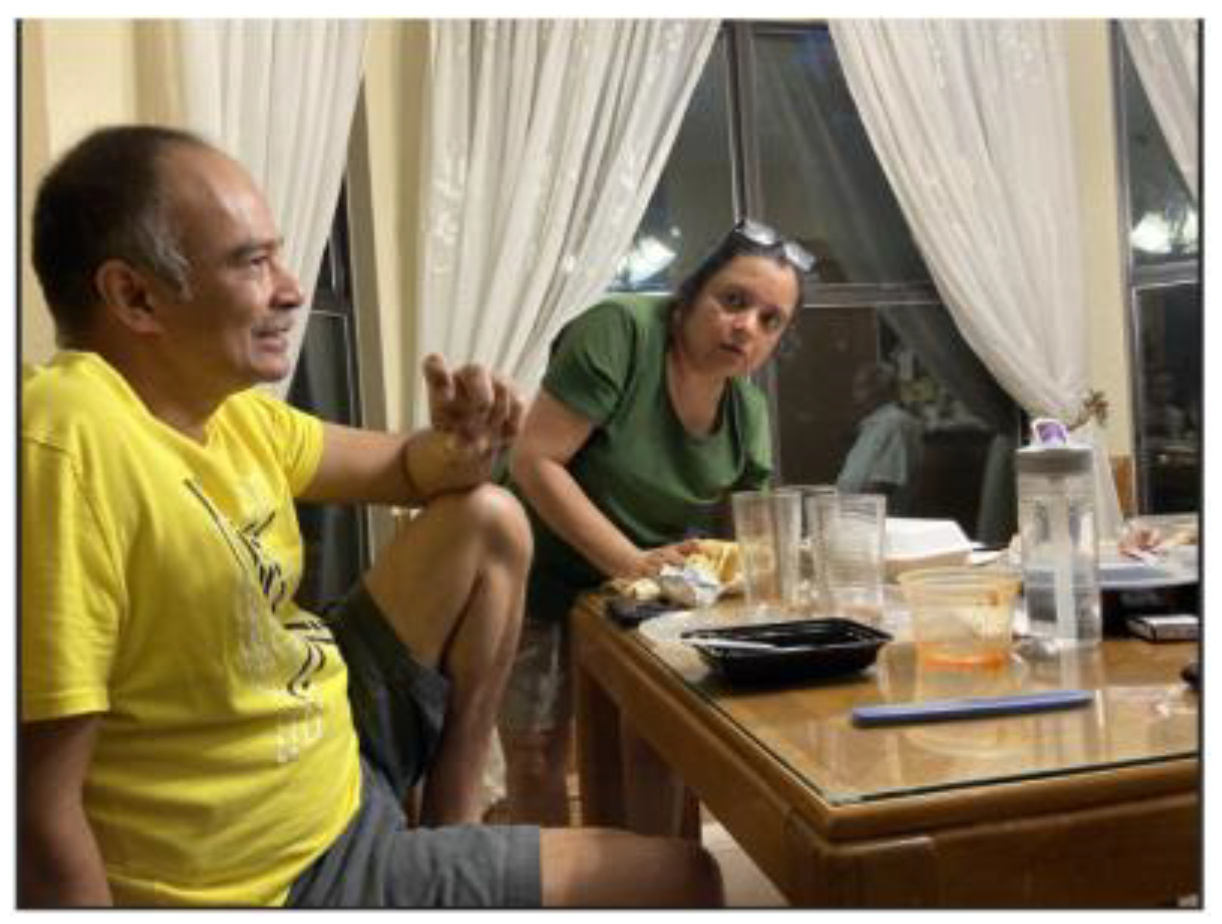
Figure 9.
Lana’s photo for mental health and well-being Photovoice prompt. Note that the caption is written by Lana: I was at the Congress Avenue Bridge here with a goal of taking good pictures. I don’t have a lot of confidence when it comes to my appearance. When I was younger, my relatives with their unrealistic beauty standards would tell me everything that was wrong with my looks. I grew up feeling insecure about my looks, and I became extremely camera shy. I was still working on my confidence while taking this picture. But in the end, I managed to genuinely laugh and my friend captured it.
Figure 9.
Lana’s photo for mental health and well-being Photovoice prompt. Note that the caption is written by Lana: I was at the Congress Avenue Bridge here with a goal of taking good pictures. I don’t have a lot of confidence when it comes to my appearance. When I was younger, my relatives with their unrealistic beauty standards would tell me everything that was wrong with my looks. I grew up feeling insecure about my looks, and I became extremely camera shy. I was still working on my confidence while taking this picture. But in the end, I managed to genuinely laugh and my friend captured it.
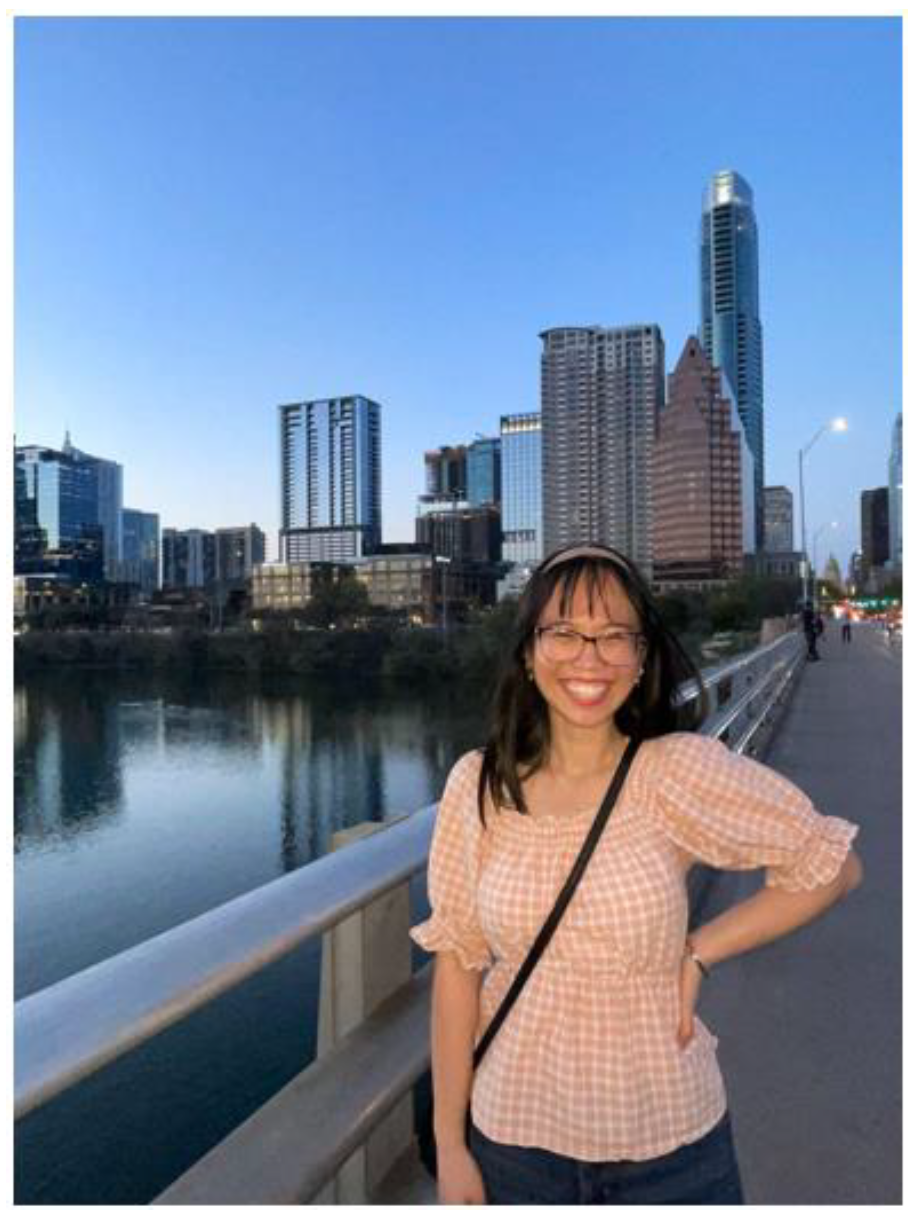
Figure 10.
Pastel Pink’s photo (a) for mental health and well-being Photovoice prompt. Note that the caption is written by Pastel Pink: Sing your Heart Out.
Figure 10.
Pastel Pink’s photo (a) for mental health and well-being Photovoice prompt. Note that the caption is written by Pastel Pink: Sing your Heart Out.
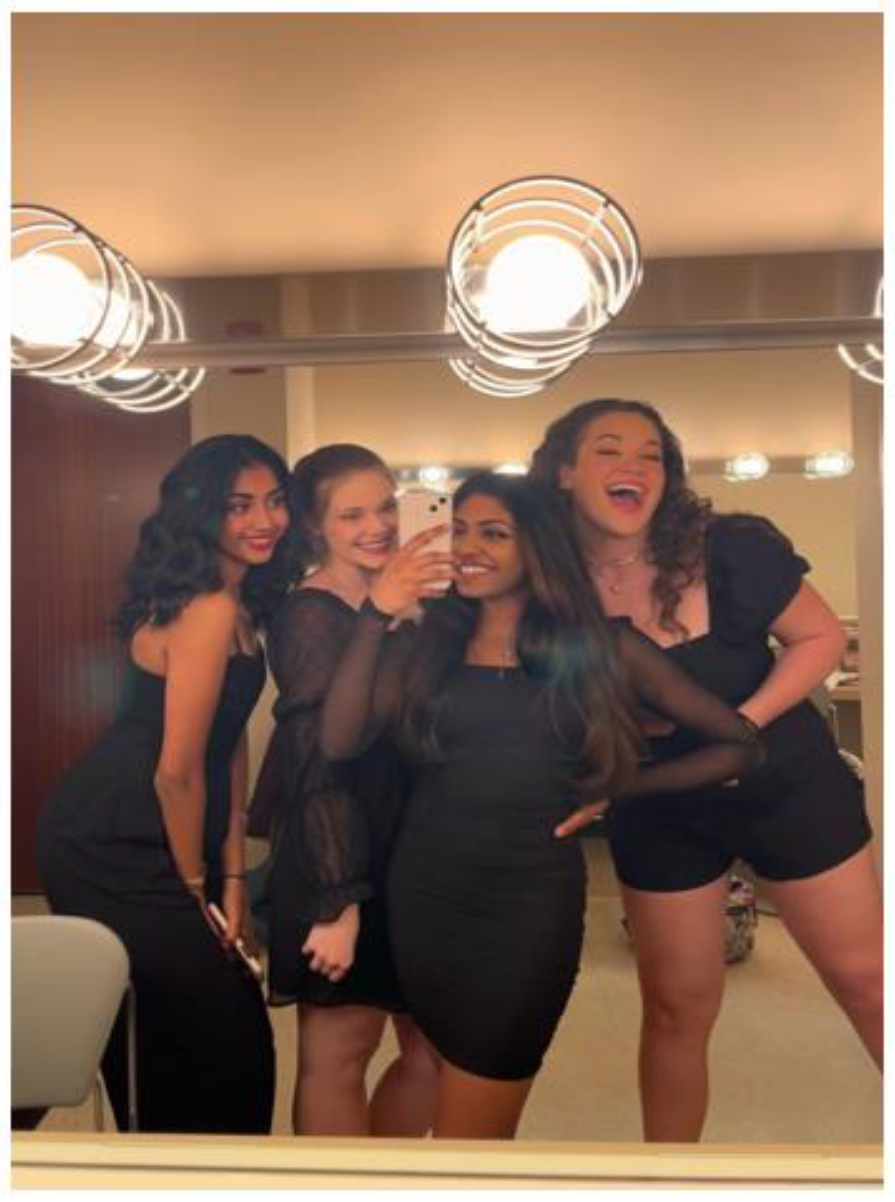
Figure 11.
Pastel Pink’s photo (b) for mental health and well-being Photovoice prompt. Note that the caption is written by Pastel Pink: Party Time.
Figure 11.
Pastel Pink’s photo (b) for mental health and well-being Photovoice prompt. Note that the caption is written by Pastel Pink: Party Time.
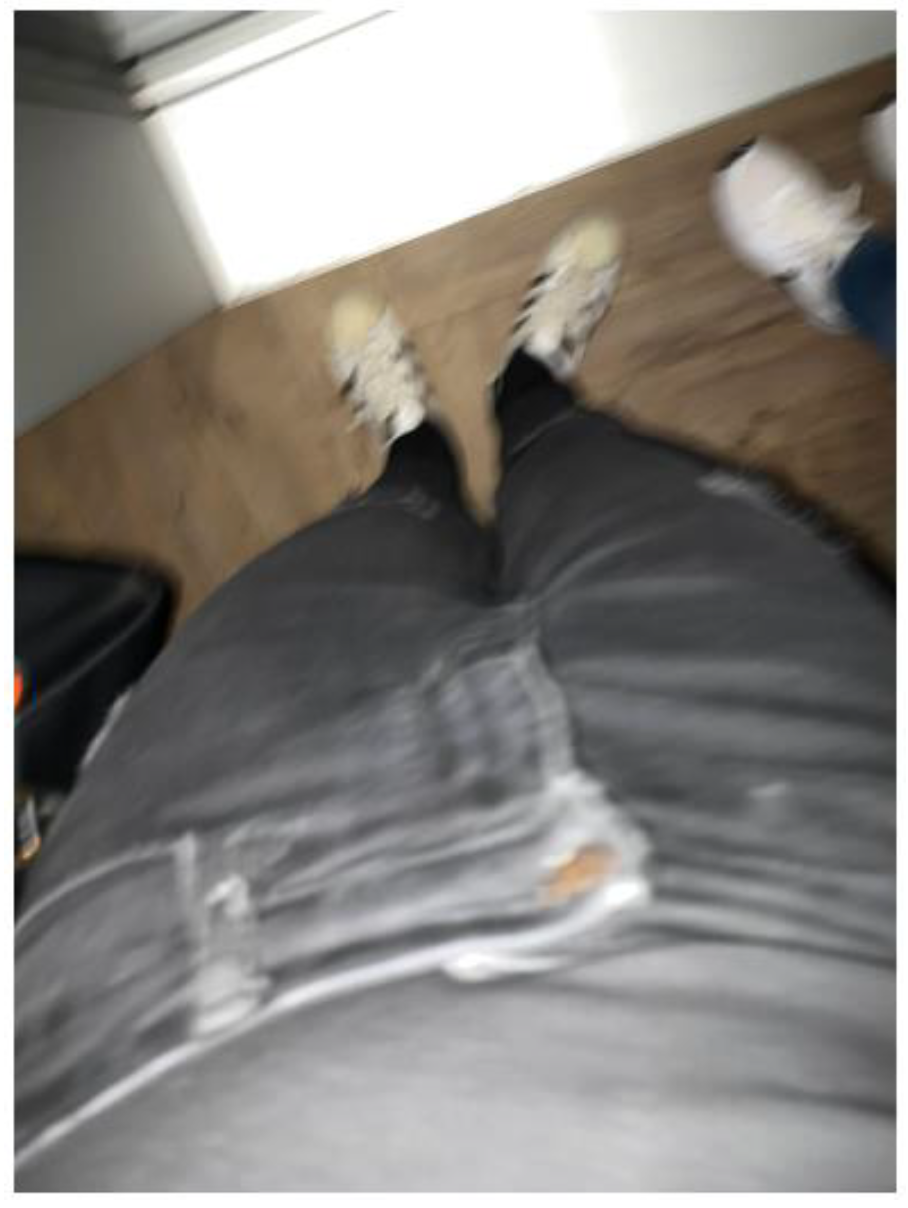
Figure 12.
Hazel’s photo for mental health and well-being Photovoice prompt. Note that the caption is written by Hazel: This is a follow-up diary entry (also about burnout, written 7 May 2022) describing loneliness now that many people I know are comfortable joining crowds and socializing in groups, whereas I keep quarantining because I’m scared of getting COVID, unwilling to get sick, and too introverted for crowds anyways. This has been a very exhausting school year. I’m in an accelerated master’s of public health program, so I am both [hyper-aware] of COVID and [hyper-aware] that everyone keeps congratulating me for being ‘so smart’ and ‘ambitious!’ but I just feel alone. My public health classes are all online, so I don’t even know my classmates and I don’t have any photos of classrooms to contribute here in this Qualtrics form.
Figure 12.
Hazel’s photo for mental health and well-being Photovoice prompt. Note that the caption is written by Hazel: This is a follow-up diary entry (also about burnout, written 7 May 2022) describing loneliness now that many people I know are comfortable joining crowds and socializing in groups, whereas I keep quarantining because I’m scared of getting COVID, unwilling to get sick, and too introverted for crowds anyways. This has been a very exhausting school year. I’m in an accelerated master’s of public health program, so I am both [hyper-aware] of COVID and [hyper-aware] that everyone keeps congratulating me for being ‘so smart’ and ‘ambitious!’ but I just feel alone. My public health classes are all online, so I don’t even know my classmates and I don’t have any photos of classrooms to contribute here in this Qualtrics form.
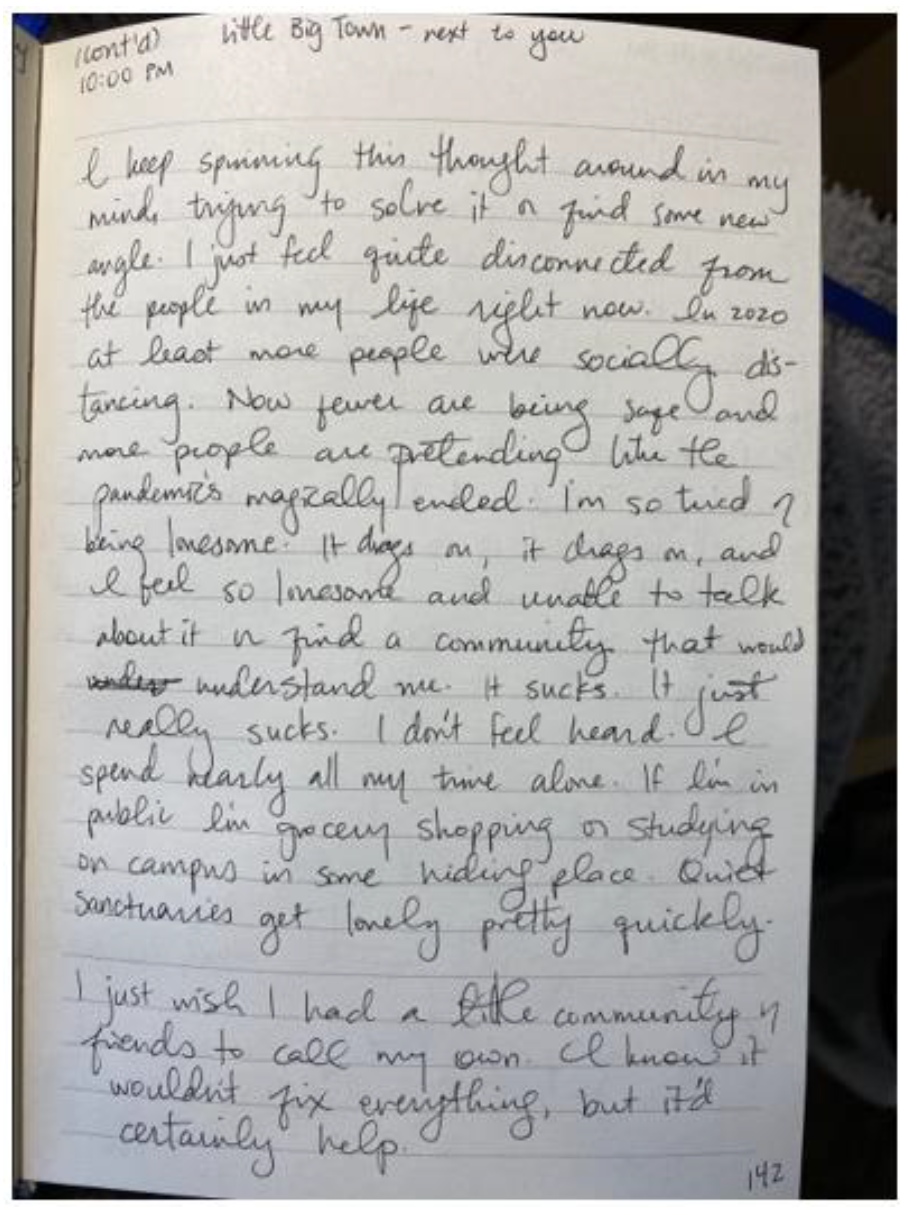
Figure 13.
Alphonse’s photo for mental health and well-being Photovoice prompt. Note that the caption is written by Alphonse: I find myself staying at the school library until 2 or 3 am on particularly challenging weeks because I don’t trust myself to work at home after years of bad habits doing schoolwork in bed. So when I do get back to my usual UT apartment I immediately knock out if I even so much as dare step in bed. I appreciate that I’ve found more ways to separate work and school than before rather than letting school follow me home, but the boundary’s only really maintained if I’m extra-diligent with 12-h shifts at school on test weeks and avoiding home as much as possible to prevent taking 8-h ‘naps’ or breaks from exhaustion on particularly challenging weeks of schoolwork. The pose is the usual configuration for me using my phone in bed after school (and usually as a prelude to my inevitable sleepiness not long after).
Figure 13.
Alphonse’s photo for mental health and well-being Photovoice prompt. Note that the caption is written by Alphonse: I find myself staying at the school library until 2 or 3 am on particularly challenging weeks because I don’t trust myself to work at home after years of bad habits doing schoolwork in bed. So when I do get back to my usual UT apartment I immediately knock out if I even so much as dare step in bed. I appreciate that I’ve found more ways to separate work and school than before rather than letting school follow me home, but the boundary’s only really maintained if I’m extra-diligent with 12-h shifts at school on test weeks and avoiding home as much as possible to prevent taking 8-h ‘naps’ or breaks from exhaustion on particularly challenging weeks of schoolwork. The pose is the usual configuration for me using my phone in bed after school (and usually as a prelude to my inevitable sleepiness not long after).
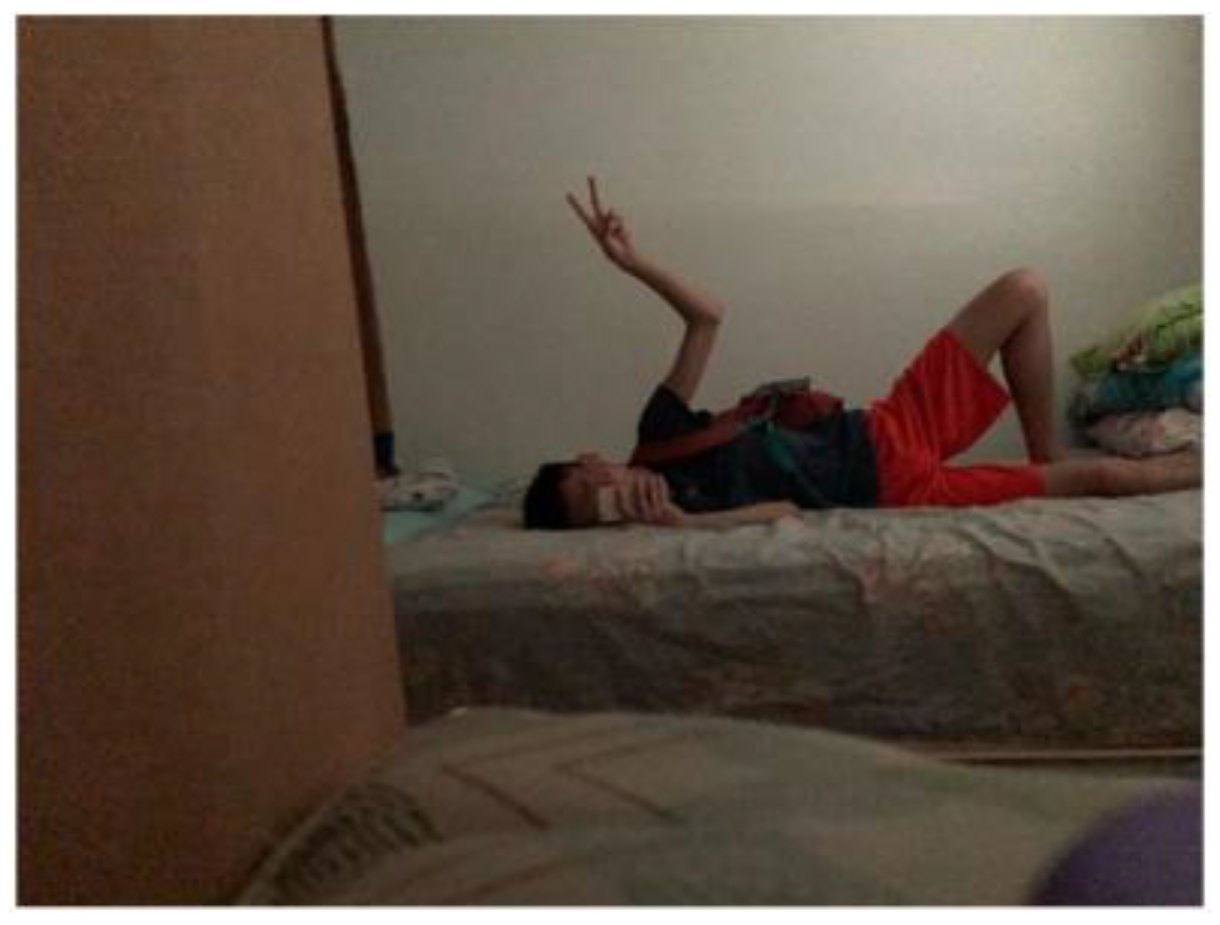
Figure 14.
Finn’s photo (b) for mental health and well-being Photovoice prompt. Note that the caption is written by Finn: This is a photo of a sketch I drew. It was inspired by a scene from a Wong Kar Wai movie “As Tears Go By”. The actual shot from the movie that I drew inspiration from was just the main character drinking water, but I drew this sketch with a more pained expression. The sketch more resembles a man drinking alcohol. I don’t personally have an alcohol problem but I do have a nicotine problem. I think that it’s pretty easy to fall back on certain habits or substances in times of stress.
Figure 14.
Finn’s photo (b) for mental health and well-being Photovoice prompt. Note that the caption is written by Finn: This is a photo of a sketch I drew. It was inspired by a scene from a Wong Kar Wai movie “As Tears Go By”. The actual shot from the movie that I drew inspiration from was just the main character drinking water, but I drew this sketch with a more pained expression. The sketch more resembles a man drinking alcohol. I don’t personally have an alcohol problem but I do have a nicotine problem. I think that it’s pretty easy to fall back on certain habits or substances in times of stress.
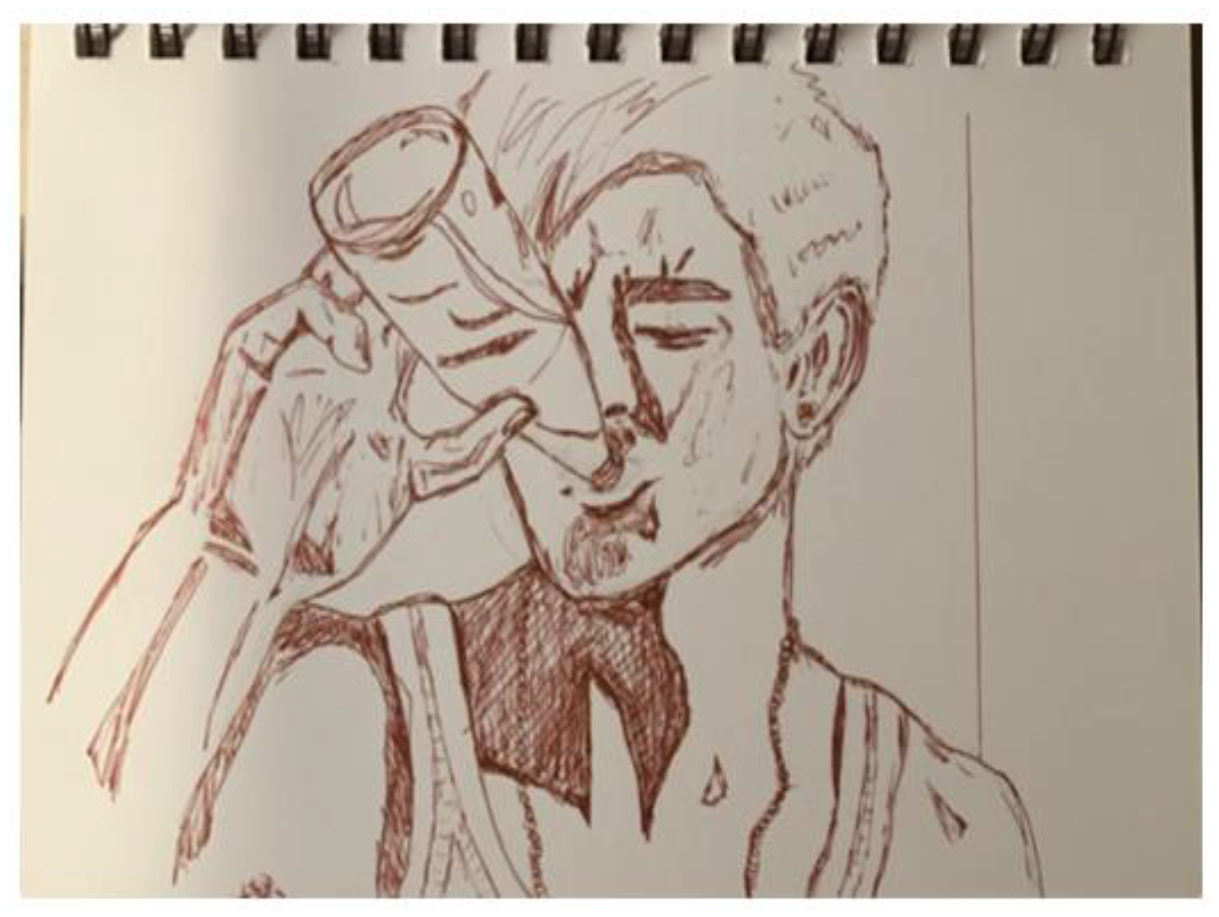
Figure 15.
Concept map of mental health.
Figure 15.
Concept map of mental health.
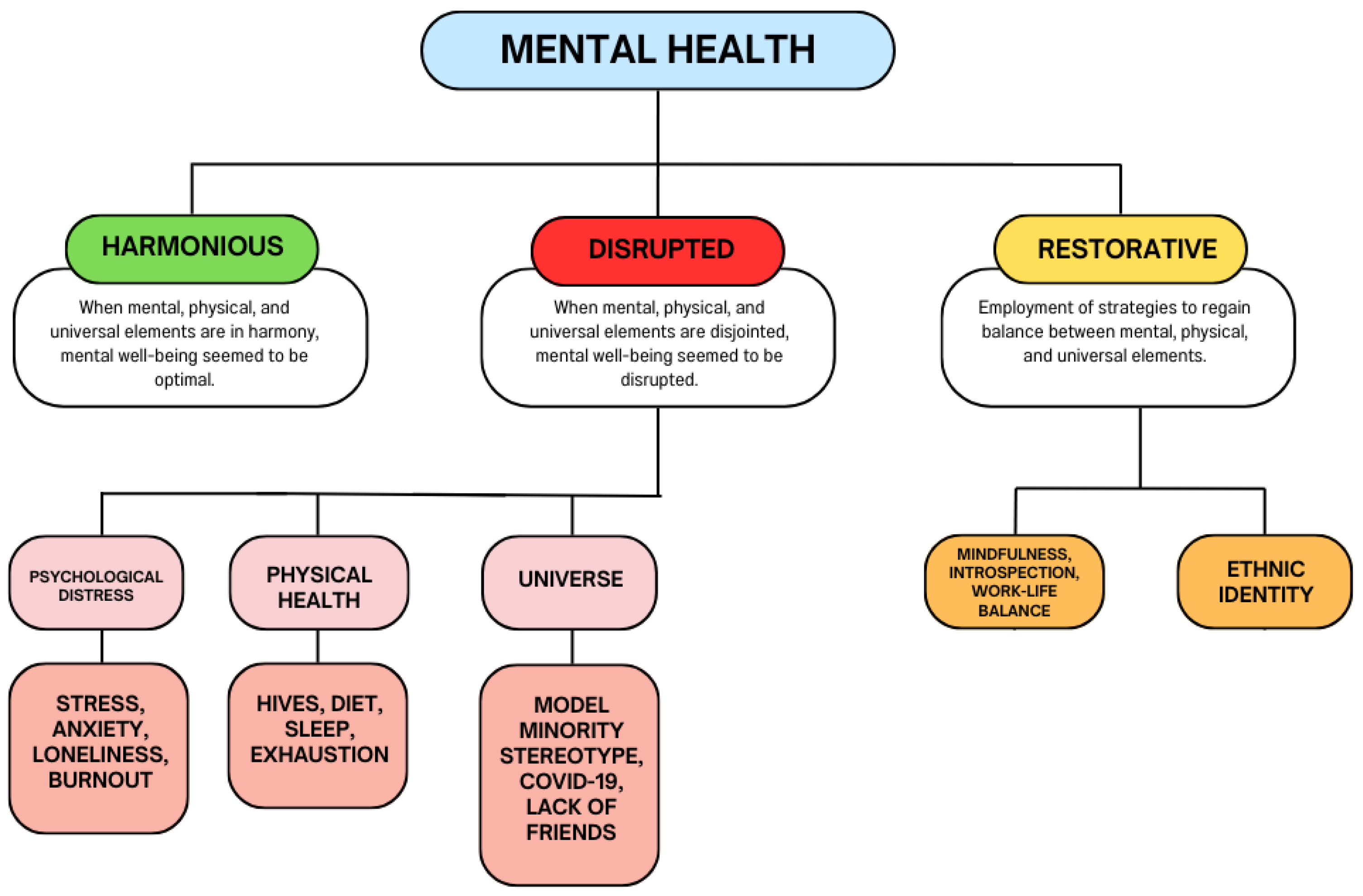
Table 1.
Participant characteristics.
Table 1.
Participant characteristics.
| Pseudonym Chosen by Participant |
Age | Ethnicity | Sex | Gender Identity, Sexual Orientation | Perceived SES Level (1–10) |
U.S. Born |
Year in School | Major/Field of Study |
|---|---|---|---|---|---|---|---|---|
| Hazel | 21 | Chinese | Female | Cis, Straight | 7 | Yes | 4th | Public Health |
| Redacted | 20 | Korean | Male | Cis, Straight | 6 | Yes | 3rd | Accounting |
| Jellybean | 21 | Asian Indian |
Female | Cis, Straight | 4 | Yes | 3rd | Management Information Systems |
| Pastel Pink | 19 | Asian Indian |
Female | Cis, Straight | 7 | Yes | 2nd | Public Health |
| Roman | 21 | Filipino | Male | Cis, Gay/Questioning/Straight | 6 | Yes | 3rd | Communication and Leadership |
| Eli | 20 | Asian Indian |
Female | Cis, Lesbian | 7 | Yes | 2nd | Electrical and Computer Engineering |
| Lana | 20 | Vietnamese | Female | Cis, Straight | 4 | No | 2nd | Math |
| Finn | 21 | Filipino | Male | Cis, Gay | 8 | Yes | 4th | Public Health |
| Alphonse | 19 | Vietnamese | Male | Cis, Gay | 7 | Yes | 2nd | Chemistry |
| Spencer | 18 | Asian Indian |
Female | Cis, Bi-/Pan-sexual/ Fluid |
7 | Yes | 1st | Civil Engineering |
| New York City | 21 | Chinese | Male | Cis, Straight | 6 | No | 4th | Management Information Systems and Urban Studies |
| Grand | 19 | Vietnamese | Female | Cis, Sapphic | 8 | Yes | 1st | Environmental Science and History |
| St. Nick | 19 | Asian Indian |
Male | Cis, Straight | 8 | No | 1st | Biochemistry |
| Blue | 18 | Pakistani | Male | Cis, Straight | 4 | Yes | 1st | Business |
|
Disclaimer/Publisher’s Note: The statements, opinions and data contained in all publications are solely those of the individual author(s) and contributor(s) and not of MDPI and/or the editor(s). MDPI and/or the editor(s) disclaim responsibility for any injury to people or property resulting from any ideas, methods, instructions or products referred to in the content. |
[ad_2]


